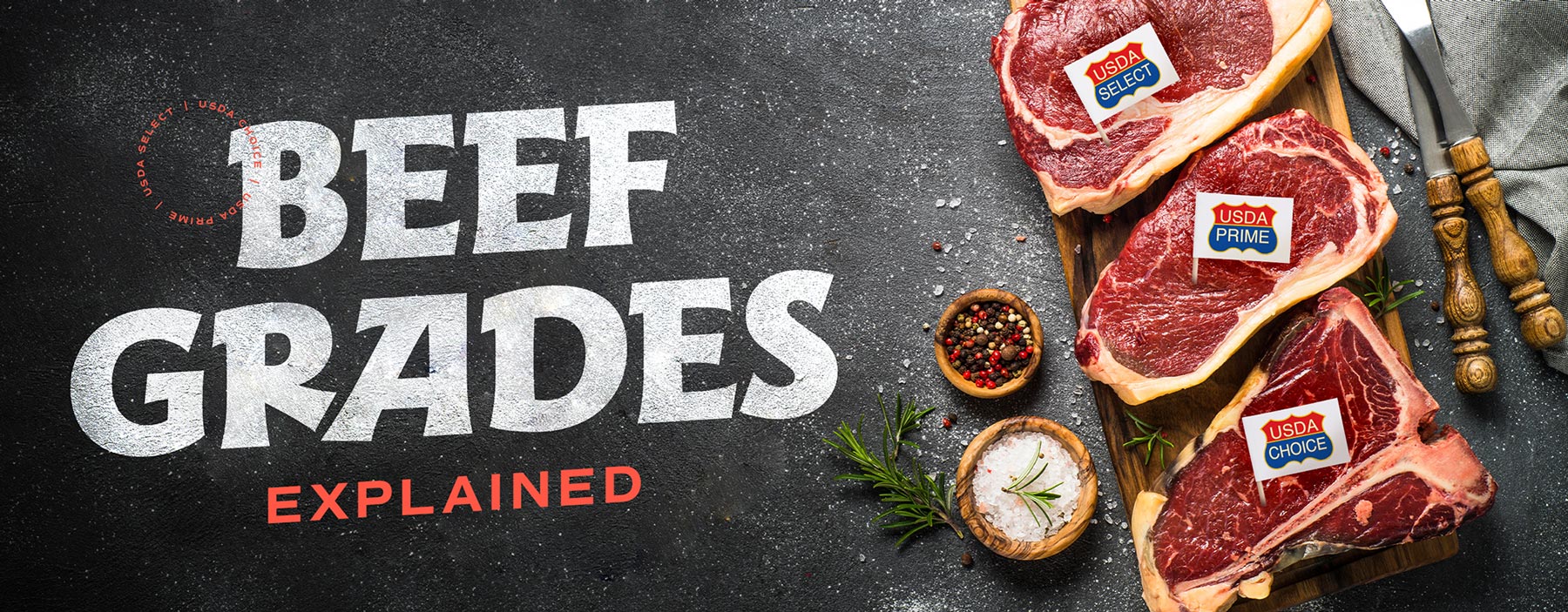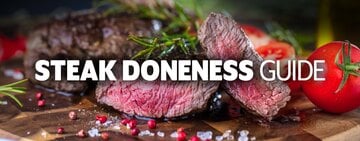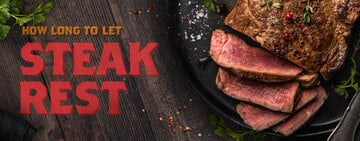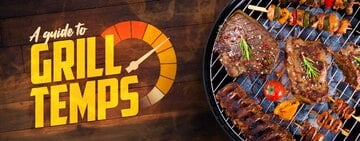Why are some pieces of steak more expensive than others even though they are of the same cut? The answer will most likely come down to the quality grading it received from the United States Department of Agriculture (USDA). If you’re opening a butcher shop or operating a steakhouse, it’s important to understand beef grades and be able to communicate what they mean to your customers. We’ll explain the difference between the quality grades of beef so you get the most for your money the next time you see a USDA shield.
Shop All BeefHow Is Beef Graded?
Beef quality grades are assigned based on the meat’s intramuscular fat marbling and the maturity of the cattle at the time of slaughter. These USDA meat grades help identify the juiciness and tenderness of the meat when cooked.
Beef can also be assigned a yield grade by the USDA which refers to the amount of lean meat on a carcass. This number grade is used during the harvesting and distribution process to market cattle.
What Are the Grades of Beef?
The eight grades of beef are prime, choice, select, standard, commercial, utility, cutter, and canner. Although there are eight grades, only the first three are considered noteworthy. Although all meat must be inspected by the USDA for safety, not all are scored for their quality. Beef processors can request a grading to earn their product the recognizable symbol of quality assurance, setting their meat above the rest. An inspector will then judge the amount of fat distribution between the 12th and 13th rib. Once inspected, beef cuts are assigned a grade that can be used for pricing and marketing.
1. Prime Beef
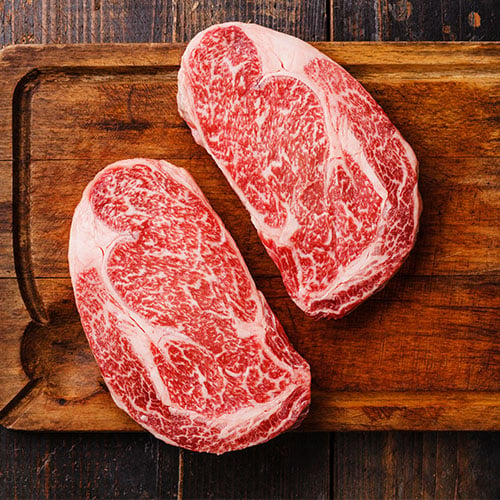
Prime beef is the highest grade a piece of beef can receive. If the USDA awards a prime quality grading, that means that the beef has abundant marbling, with 8-13% fat, and is from a young, well-fed cow. Only about 2-5% of beef sold in the foodservice industry receives this grading.
Prime grade beef is usually used in fine dining settings like high-end restaurants, steakhouses, and hotels. Because of its marbling, prime beef is incredibly juicy, tender, and flavorful when prepared. Prime beef benefits from dry-heat cooking, like broiling, roasting, and grilling. It is also a great candidate for sous vide cooking, creating a melt-in-your-mouth experience.
- Prime Beef Marbling: Abundant, 8-13% Fat
- Prime Beef Source: Young, well-fed cattle (Between ages of 9-30 months)
- Prime Beef Characteristics: Extremely tender, juicy, and flavorful
- How to Cook Prime Beef: Grilled, broiled, roasted, sous vide
- Prime Beef Cuts: Prime rib, wagyu
2. Choice Beef
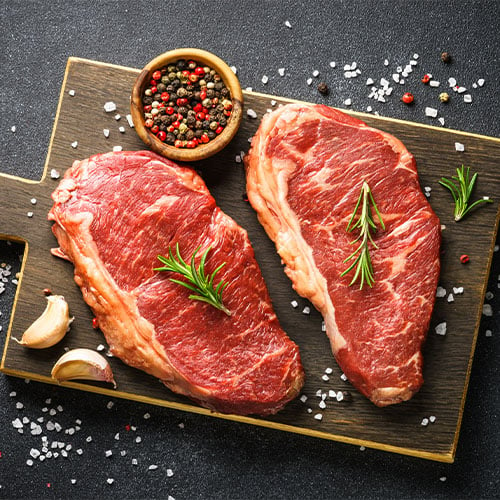
Choice beef is one of the most common USDA beef grades in the foodservice industry, with approximately 50-55% of cattle receiving this rating. At the choice grading level, the meat features around 4-10% fat marbling, sourced from the loin or ribs of a young, well-fed cow. Angus beef is the most well-known example of choice grade quality meat.
Because choice grade beef has a high-quality standard without bearing an exorbitant price tag, it is a popular option for restaurant menus and different types of barbeque. Even though it features less marbling than prime grade meat, choice beef’s moderate fat percentage makes it still juicy and flavorful. It is slightly less tender than prime cuts, which means choice quality beef benefits from being tenderized before being braised, roasted, or simmered. You can still cook choice beef with dry heat but it will be more susceptible to overcooking than prime beef.
- Choice Beef Marbling: Moderate, 4-10% Fat
- Choice Beef Source: Young, well-fed cattle (Between ages of 9-30 months)
- Choice Beef Characteristics: Tender, slightly juicy, quality at lower price point
- How to Cook Choice Beef: Braised, roasted, simmered
- Choice Beef Cuts: Ribeye, sirloin
Prime vs Choice Beef
The difference between prime and choice beef is that prime grade beef features an abundant fat marbling at 8-13% fat while choice beef has only 4-10% fat. This makes prime grade beef more tender, flavorful, and juicer than choice grade beef when cooked. Prime beef is usually reserved for fine dining settings while choice grade beef is typically found in casual dining restaurants.
3. Select Beef
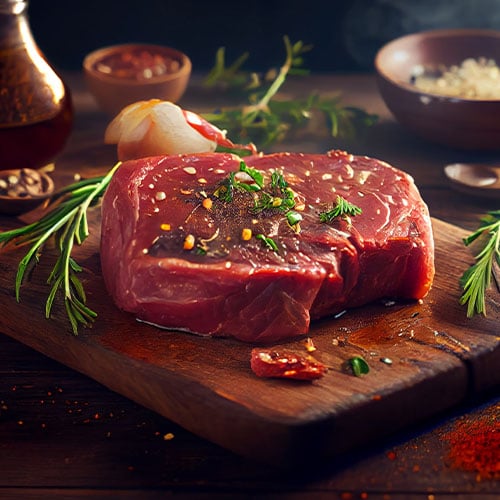
Select beef is a popular option in retail markets for its uniformity and lower price tag. This leaner grading only has approximately 2-4% fat marbling, meaning that it will lack natural juiciness and tenderness. This cut benefits the most by using a meat tenderizer in preparation. Despite the lower fat ratio, select meat is still sourced from a well-fed, young cow and is considered high-quality beef.
Select grade beef is often one of the top options in local grocery stores, favored for its affordability while still bearing the USDA badge of quality. Its lack of marbling means the meat would need tenderizing and the help of marinades to keep it from getting tough in the cooking process. This also means that select grade beef is lean in comparison to higher grades, making it a great choice for healthier menus. Select beef can be smoked, braised, or stewed to reintroduce moisture into the meat.
- Select Beef Marbling: Modest to small, 2-4% Fat
- Select Beef Source: Young, well-fed cattle (Between ages of 9-30 months)
- Select Beef Characteristics: Lean, affordable but meets quality standards of USDA
- How to Cook Select Beef: Smoked, braised, stewed
- Select Beef Cuts: Brisket, chuck, shank
Choice vs Select Beef
The difference between choice and select beef is that choice grade beef has 4-10% fat while select has 2-4% fat, making choice grade beef more tender and juicier than select. Choice beef will often be used in chain restaurants while select beef is sold for retail and residential use.
Prime vs Choice vs Select
When comparing the three top grades of beef, you’ll find that prime beef has abundant marbling and comes with the highest price tag, often being the prized purchase at a steakhouse. Choice beef has moderate marbling, making it a more attainable but still high-quality option for restaurant goers. Select beef has very little marbling, making it the leanest of the top three grades. It is more affordable but may require special care during the preparation process to ensure that the final result is tender and not dried out.
4. Standard Beef
Any piece of beef sold below select grade gets very little attention in the foodservice industry. Standard grade beef is often sourced from a more mature cow (age between 30-42 months) and will only have slight traces of marbling. It is often ungraded or listed as store-brand meat and is usually the most affordable option sold in a grocery store. Standard grade beef should be tenderized and marinated to add moisture and flavor to the meat.
5. Commercial Beef
Commercial grade beef is typically reserved for high-quality and lean ground beef blends. Because they lack marbling and are from older cattle, they are added with other beef cuts to create ground beef suitable for hamburgers and meatballs at an economic price point.
6. Utility, Cutter, and Canner Beef
The last three beef grades are often bundled together as they are typically not sold raw for foodservice. Utility beef is predominantly reserved for processed meat products, like frozen meals and canned stews. Cutter and canner grade beef is often used to make pet food.
Beef Yield Grades
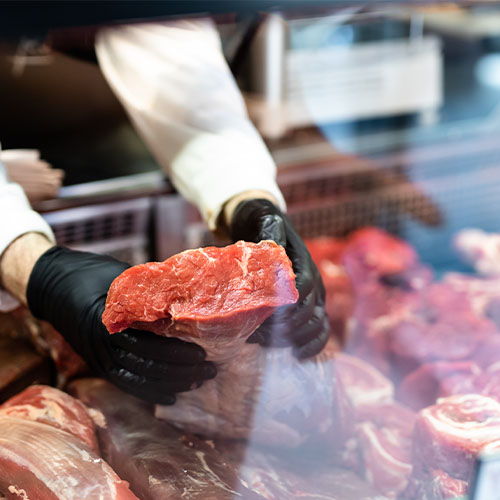
Beef can receive a yield grading by the USDA during the harvesting process to indicate how much meat was collected from an individual carcass. This is graded on a 1 through 5 score based on red meat compared to fat trimmings from an animal, and it is intended for cattle marketing purposes. The higher the score, the more fat trimmings in the four primal cuts (chuck, rib, round, and loin), with 1 meaning mostly red meat and 5 meaning very fatty.
The USDA inspector checks the 12th rib cross-section, where the ribeye cut is taken from, for firmness, fat distribution, texture, and cartilage. Cattle producers can then use this score to determine how many boneless, trimmed beef cuts they’ll be able to get from a single carcass to put into wholesale.
Avoid grilling mistakes by choosing the best quality beef for your customers. The USDA beef grades are there to help you identify the marbling in a piece of meat and find the right fit for your recipes. Advertise your steak’s grade on your menu to have your guests coming back for more.

